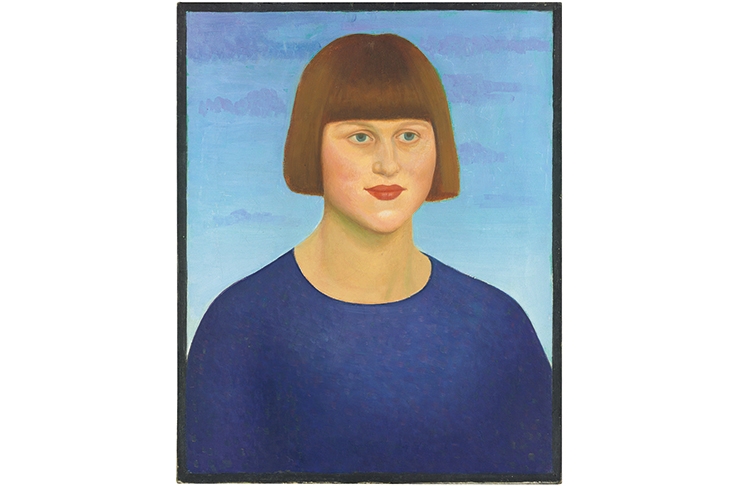Dora Carrington (1893–1932) was at the heart of the Bloomsbury story. As an art student, she encountered the love of her life, the homosexual biographer Lytton Strachey; and this pair of Edwardian virgins actually managed to consumate their relationship in 1916. She loathed her given name, and insisted on her new friends, such as Virginia Woolf, Maynard Keynes, Duncan Grant and the entire large clan of Stracheys using her surname alone.
Whatever her merits as an artist, the dramatic story of her life with the Bloomsbury group, and death by her own hand, is so enthralling that it was made into a film, in 1995, with Emma Thompson playing the title role. Like her frustrated suitor and fellow Slade student, Mark Gertler, she painted at least one masterpiece. In Carrington’s case, this was the National Portrait Gallery’s portrait of Lytton Strachey. Painted in 1916, when Strachey was in his mid-thirties, it shows him in profile reclining, reading a book, with his fine hands and long fingers and every whisker of his full red beard lovingly detailed. How you rate Carrington as a painter is largely a matter of taste; but though probably mildly dyslexic, she was a superb writer of letters.
This first came to attention when Michael Holroyd quoted some of them in his pioneering two-volume biography of Strachey, and was made gratifyingly clear in David ‘Bunny’ Garnett’s 1970 selection of her heavily illustrated letters and extracts from her diaries. There were problems with his editing, in that he seems not to have had full access to her often passionate letters to one of her lovers, the Hispanist Gerald Brenan; and he omitted some good letters to Gertler and others. Moreover, many recipients of Carrington’s letters were still alive in 1970, and Garnett would not, for example, have wanted to embarrass Frances Partridge by publishing vituperative letters about her, written when Frances was starting her own affair with Carrington’s husband, Ralph Partridge. (Carrington only stuck with Ralph because Lytton adored him, and she was afraid of breaking up their ménage à trois.)
My own edition of the letters of Lytton Strachey (revised in 2006) was not subjected to considerations of tact, as almost everyone mentioned was dead, and it has long been felt that it was time for another, fuller edition of the Carrington letters. These are good reasons to welcome this new volume edited by Anne Chisholm, the distinguished biographer of Frances Partridge — and it is a particularly handsome production, designed to resemble one of the books that issued from the Woolfs’ Hogarth Press.
As one would expect, there are many more recipients of Carrington’s epistles than Bunny Garnett was able to muster: members of the family of Augustus John, to whom she was close in the last years of her brief life, plus Rosamond Lehmann, Dadie Rylands and Roger Senhouse (Strachey’s partner in S/M experiments), all still living when the last edition came out. Bloomsbury fans, and those who merely love reading other people’s letters, will cheer this new collection of mostly very good writing, with their line drawings, gorgeous, concrete descriptions of people, places and things, and details of what she ate, painted and was reading. And Chisholm’s own introduction and postscript are splendid examples of fine prose.
Comparing Garnett and Chisholm is intriguing. Chisholm is more generous in giving space to Carrington’s lesbian dalliance with the ‘Kentucky princess’ Henrietta Bingham. She has, however, removed some coarse anti-Semitism from a letter to Brenan of 13 June 1924, and omitted entire letters to him from the month before, including an amusing rude poem on 26 May, and a great letter that June, telling Brenan that ‘my secret life is with you’.
Chisholm commits one egregious error. She consistently labels as ‘pacifist’ the Bloomsbury conscientious objectors to conscription in the first world war.Scarcely any of them (except for Duncan Grant — and Frances Partridge, who is the obvious source of this vulgar mistake) were pacifists in the sense of categorically rejecting war. Virtually all of them subscribed to Strachey’s anti-conscription statement, which said that he did not believe ‘that I should never, in any circumstances, be justified in taking part in any conceivable war’. It is offensive both to the careful use of language and to the memory of the COs, because they genuinely risked imprisonment for the stand they took.
In the end, though, my main regret is that so many of these letters have been trimmed or omitted. It would be glorious if we could read Carrington’s letters together with Strachey’s, Brenan’s and the rest of her correspondents (in the dozen volumes it would surely take). In the meantime, what is needed — both for scholars and interested general readers — is not this excellent edition of extracts but Carrington’s complete correspondence.






Comments